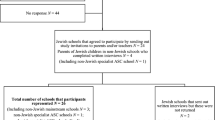Abstract
While partnerships including meaningful, two-way, parent–teacher dialogue about young children during early childhood program and school meetings are critical, linguistic differences between bilingual parents who are immigrants and early educators can impede communication and lead to inequitable services. In this article, we focus on one aspect of linguistic differences for educators and bilingual parents: English-language adjectives used by teachers to describe young children. We highlight aspects of adjectives, their uses, and cultural contexts to illustrate potential misunderstandings that may lead to not only miscommunication but also challenges to partnerships and equitable early childhood service provision. Subsequently, we present recommendations to foster meaningful dialogue and greater understanding between educators and bilingual parents who are immigrants when dialoguing about young children.
Similar content being viewed by others
References
Beneke, M. R., & Cheatham, G. A. (2016). Inclusive, democratic family–professional partnerships: (Re)conceptualizing culture and language in teacher preparation. Topics in Early Childhood Special Education, 35(4), 234–244.
Cheatham, G. A., & Jimenez-Silva, M. (2012). Partnering with Latino families during kindergarten transition: Lessons learned from a parent–teacher conference. Childhood Education, 88, 177–184.
Cheatham, G. A., & Ostrosky, M. M. (2009). Listening for details of talk: Early childhood parent–teacher conference communication facilitators. Young Exceptional Children, 13(1), 36–49.
Cheatham, G. A., & Ro, Y. E. (2011a). Communication between early educators and parents who speak English as a second language: A semantic and pragmatic perspective. Early Childhood Education Journal, 39, 249–256.
Cheatham, G. A., & Ro, Y. E. (2011b). A linguistic perspective on communication with parents who speak English as a second language: Phonology, morphology, and syntax. Early Child Development and Care, 181, 1247–1260.
Cheatham, G. A., & Santos, R. M. (2005). A–B–C’s of bridging home and school expectations for children and families of diverse backgrounds. Young Exceptional Children, 8(3), 3–11.
Chen, X., Chung, J., & Hsiao, C. (2009). Peer interactions and relationships from a cross-cultural perspective. In K. H. Rubin, W. M. Bukowski, & B. Laursen (Eds.), Handbook of peer interactions, relationships and groups (pp. 432–454). New York: Guilford.
Chen, X., & Rubin, K. H. (2011). Culture and children’s socioemotional functioning: Contextual-developmental perspective. In X. Chen & K. H. Rubin (Eds.), Socioemotional development in cultural context (pp. 29–52). New York: Guilford.
Copple, C., & Bredekamp, S. (Eds.). (2009). Developmentally appropriate practice in early childhood programs: Serving children from birth to age 8. Washington, DC: National Association for the Education of Young Children.
Delgado-Gaitan, C. (2001). The power of community: Mobilizing for family and schooling. Lanham: Rowman and Littlefield.
Division for Early Childhood (2014). DEC recommended practices in early intervention/early childhood special education 2014. Retrieved from http://www.dec-sped.org/recommendedpractices.
French, D. C., Lee, O., & Pidada, S. U. (2006). Friendships of Indonesian, South Korean, and US Youth: Exclusivity, intimacy, enhancement of worth, and conflict. In X. Chen, D. C. French, & B. H. Schneider (Eds.), Peer relationships in cultural context (pp. 379–402). Cambridge: Cambridge University.
Fromkin, V., Rodman, R., & Hyams, N. (2014). An introduction to language. Boston: Wadsworth.
Gärdenfors, P. (2014). The geometry of meaning: Semantics based on conceptual spaces. Cambridge: Massachusetts Institute of Technology.
Gee, J. P. (2004). Situated language and learning: A critique of traditional schooling. London: Routledge.
Gee, J. P. (2014a). An introduction to discourse analysis: Theory and method. New York: Routledge.
Gee, J. P. (2014b, October). Language as system and situation: Writing the world. In: Maryland Conference on Academic and Professional Writing. College Park, MD.
Gonzalez, N., Moll, L. C., & Amanti, C. (2005). Funds of knowledge: Theorizing practices in households, communities, and classrooms. Mahwah: Taylor & Francis.
Harry, B. (2008). Collaboration with culturally and linguistically diverse families: Ideal versus reality. Exceptional Children, 74, 372–388.
Howard, K. M., & Lipinoga, S. (2010). Closing down openings: Pretextuality and misunderstanding in parent–teacher conferences with Mexican immigrant families. Language and Communication, 30, 33–47.
Hübler, A. (1983). Understatements and hedges in English. Philadelphia: John Benjamins.
Kalyanpur, M., & Harry, B. (1999). Culture in special education. Baltimore: Paul H. Brookes.
Kalyanpur, M., & Harry, B. (2012). Cultural reciprocity in special education: Building family–professional relationships. Baltimore: Paul H. Brookes.
Kennedy, C. (1999). Projecting the adjective: The syntax and semantics of gradability and comparison. New York: Garland.
Kennedy, C. (2007). Vagueness and grammar: The semantics of relative and absolute gradable adjectives. Linguistics and Philosophy, 30, 1–45.
Lynch, E. W., & Hanson, M. J. (Eds.). (2011). Developing cross-cultural competence: A guide for working with children and their families. Baltimore: Paul H. Brookes.
Matthews, P. H. (2014). The concise Oxford dictionary of linguistics. Oxford, UK: Oxford University.
National Clearinghouse for English Language Acquisition (2011). Key demographics and practice recommendations for young English learners. Available at http://www.ncela.us/files/uploads/9/EarlyChildhoodShortReport.pdf.
Parmar, P., Harkness, S., & Super, C. M. (2008). Teacher or playmate? Asian immigrant and European–American parents’ participation in their young children’s daily activities. Social Behavior and Personality: An International Journal, 36, 163–176.
Rogoff, B. (2003). The cultural nature of human development. New York: Oxford University Press.
Salas, L. (2004). Individualized education plan (IEP) meetings and Mexican–American parents: Let’s talk about it. Journal of Latinos in Education, 3(3), 181–192.
Shields, C. M. (2007). Bakhtin primer. New York: Peter Lang Publishing.
Turnbull, A. P., Turnbull, H. R., Erwin, E. J., Soodak, L. C., & Shogren, K. A. (2015). Families, professionals, and exceptionality: Positive outcomes through partnerships and trust. Boston: Pearson.
Author information
Authors and Affiliations
Corresponding author
Rights and permissions
About this article
Cite this article
Cheatham, G.A., Nyegenye, S. Linguistic Differences with Bilingual Parents Who are Immigrants: Words for Dialoguing About Young Children. Early Childhood Educ J 45, 685–692 (2017). https://doi.org/10.1007/s10643-016-0803-0
Published:
Issue Date:
DOI: https://doi.org/10.1007/s10643-016-0803-0




